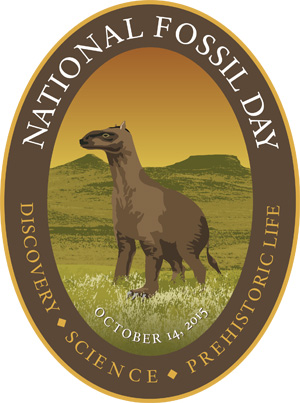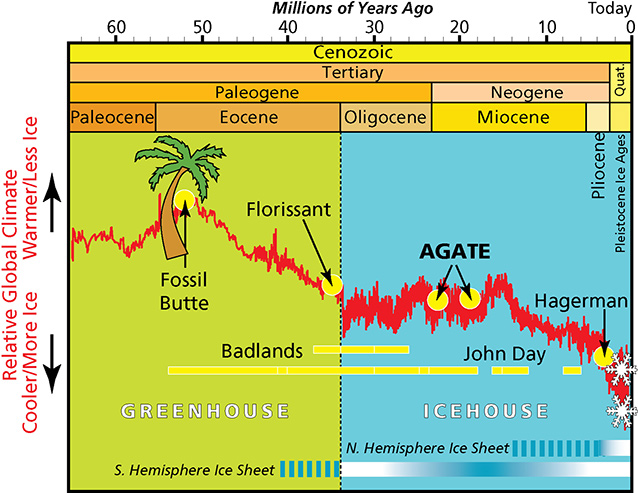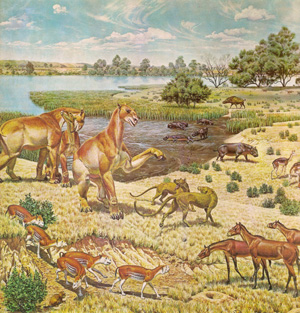Cenozoic ecosystems

The 2015 National Fossil Day artwork features an enigmatic prehistoric mammal known as a chalicothere (derived from Greek words meaning "gravel beast"), a large herbivore, depicted in a Miocene prairie grassland. The scene is an idealized representation of Cenozoic Era life and landscapes, which is the theme for the 2015 National Fossil Day monthly features. Each month, a different Cenozoic ecosystem and the associated animals and plants will be featured on the National Fossil Day website. To learn more about the chalicothere, along with some of the contemporary animals and plants, please revisit the National Fossil Day website in February, when we will feature Agate Fossil Beds National Monument.
Age of Mammals
The Cenozoic, the era of "Recent Life", is divided into three periods: the Paleogene, Neogene, and Quaternary; and seven epochs: the Paleocene, Eocene, Oligocene, Miocene, Pliocene, Pleistocene, and Holocene. The Cenozoic Era spans from 66 million years ago to the present. The beginning of the Cenozoic is marked by worldwide mass extinction events heralding the end of the reign of the Mesozoic reptiles, including the dinosaurs. The Mesozoic Era was featured on the 2011 and 2014 National Fossil Day logos. The National Fossil Day titanothere logo is a Cenozoic fossil as is the 2012 mammoth artwork.
The Cenozoic is also commonly referred to as the "Age of Mammals", because of the great proliferation and diversity of mammals which evolved and successfully inhabited terrestrial and marine environments worldwide during the Cenozoic. In addition to all of the different groups of mammals, birds, insects, and flowering plants greatly flourished during the Cenozoic.
One of the great stories of the Cenozoic Era is the change in climate from the "greenhouse" world of the dinosaurs to an "icehouse" world with ice sheets on the north and south poles. The changes in climate documented during the Cenozoic influenced the evolution and distribution of plants and animals. Scientists have concluded from geologic and fossil evidence that a significant global warming event occurred during the beginning of the Cenozoic. At around 50 million years ago there was a shift towards long-term cooling which resulted in reshaping Cenozoic life and landscapes. The first widespread savannas and grasslands in North America developed during the cooling period of the middle Cenozoic. Dramatic changes in vegetation and habitats influenced the animals living and feeding in these new environments.

Adapted from Zachos and others (2008).
The collective story of the Cenozoic fossil record, evolving ecosystems, and climate change provides us a greater understanding of how our modern flora, fauna and ecosystems have evolved. This understanding can guide us as we assess the effects and corresponding environmental impacts associated with current and future changes in climate.
Go See Them!

Smithsonian photo.
Many National Fossil Day partner fossil sites and museums are excellent places to learn about Cenozoic Era fossils and ecosystems. Below are just six National Park Service sites which preserve a portion of the Cenozoic story.
- Fossil Butte National Monument (Wyoming) preserves a world-renowned fossil locality representing a portion of an Eocene lake system in southwestern Wyoming. Lake sediments contain an abundance of well-preserved fossils which have been collected and studied for well over a century. Complete skeletons of fish, reptiles, birds, mammals, along with the exquisite preservation of plants and insects, provide a very rare glimpse into an ancient ecosystem.
- Florissant Fossil Beds National Monument (Colorado) is a rich and important fossil locality high in the Rocky Mountain which preserves Eocene and Oligocene fossils. Fossil plants and insects are exceptionally well preserved and extremely diverse. The park has a vibrant and active research program, which supports wonderful public education and outreach activities at the monument.
- Badlands National Park (South Dakota) is one of the world's richest deposits of fossil mammals from the Eocene and Oligocene. The park is preserves a beautiful badlands topographic landscape which preserves fossil assemblages that span a period of climatic transition from warmer to cooler temperatures. Badlands fossils help to reveal the evolution and diversification of mammals in response to the shifting paleoenvironment during the Eocene–Oligocene transition.
- John Day Fossil Beds National Monument (Oregon) preserves a 40-million-year-long fossil record within the John Day Basin. Rocks and fossils date to between the late Eocene and late Miocene, yielding a scientifically important temporal succession of life through a great portion of the Cenozoic. Mammal and plant fossils are common.
- Agate Fossil Beds National Monument (Nebraska) is an important Miocene fossil locality with a rich history of paleontological fieldwork by scientists from the Carnegie Museum of Natural History and the University of Nebraska. The fossils from Agate represent an evolving fauna showing adaptations to the cooler climates and an open savanna grasslands environment.
- Hagerman Fossil Beds National Monument (Idaho) is an important Pliocene fossil locality where over two hundred different species of fossil plants and animals have been discovered from an exposure above the Snake River. Hagerman strata contain one of the most important fossil horse localities in the world, yielding the first true horse, Equus simplicidens.
Learn more about National Fossil Day and the NFD Logos and Artwork on the official National Fossil Day website.
Part of a series of articles titled National Fossil Day Logo and Artwork – Prehistoric Life Illustrated.
Last updated: September 8, 2020
